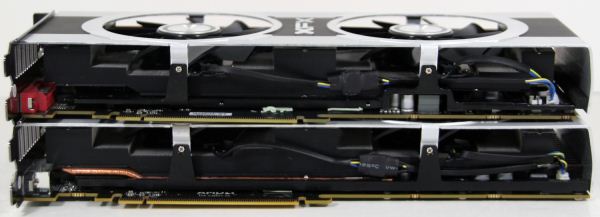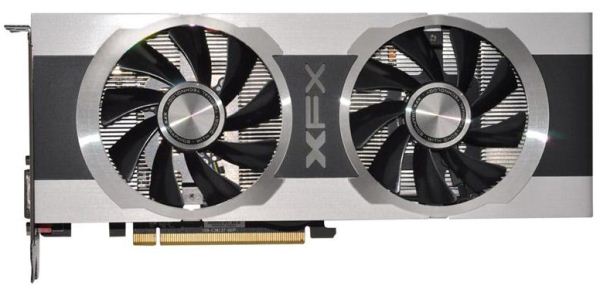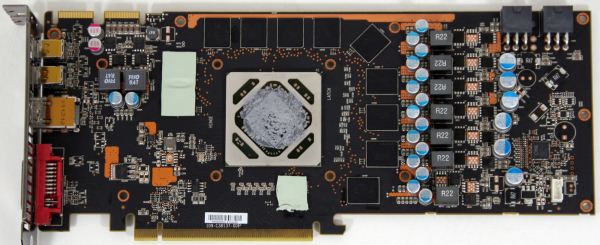AMD Radeon HD 7950 Review Feat. Sapphire & XFX: Sewing Up The High-End Market
by Ryan Smith on January 31, 2012 9:02 AM ESTMeet the XFX R7950 Black Edition Double Dissipation
Our second partner card of the day is XFX’s R7950 Black Edition Double Dissipation. Like the 7970 Black Edition Double Dissipation we reviewed earlier this month, the 7950 BEDD is a factory overclocked card (Black Edition) using XFX’s Double Dissipation cooler.
Starting with the overclock, XFX is shipping the 7950 BEDD with a core clock of 900MHz and a memory clock of 5.5GHz. This represents a 100MHz (12.5%) core clock overclock and 500MHz (10%) memory clock overclock, putting it just shy of the 925MHz core clock the 7970 ships at.
In terms of construction like all of the other 7950 cards launching today XFX is using AMD’s 7950 PCB. This means the PCB measures 10.25” long and features 2 6pin PCIe power sockets towards the rear of the card, while at the front the card uses the AMD standard port configuration of 1 DL-DVI, 1 HDMi, and 2 mini-DisplayPorts. The one notable deviation here from the Sapphire card is that XFX has not included a BIOS selection switch, so the card lacks any kind of ability to easily recover from a bad BIOS flash, and if unlocking proves viable it would not be a good candidate for the process.
Meanwhile cooling is provided by XFX’s Double Dissipation cooler. This is the same heatsink and fan assembly we saw with the 7970 BEDD, which makes this an open air cooler using a pair of fans to push air along an aluminum heatsink running almost the entire length of the card. Because it’s the same assembly, the shrouding for the card sticks out over the end of the PCB, negating the benefit of the shorter 7950 PCB and making the card 10.65” long just like the 7970 BEDD.

Top: 7950 BEDD. Bottom: 7970 BEDD
Do note that while it uses the same fan and heatsink assembly, Double Dissipation does not mean it uses the same vapor chamber assembly to transfer heat from the card. Where the 7970 BEDD used a fairly large vapor chamber, the 7950 BEDD uses a much smaller vapor chamber that only makes contact with roughly half of the heatsink, meaning that heat isn’t being transferred to the extremities of the heatsink nearly as well on the 7950 BEDD. Furthermore the aluminum plate covering the RAM and MOSFETs is poorly sized, leaving parts of the RAM chips (and their thermal pads) exposed. We’ll see how this plays out when we get to our testing, but the 7950 BEDD is clearly not as well built as the 7970 BEDD.
Rounding out the package is the same collection of extras that we saw in the 7970 BEDD. Inside you’ll find the usual driver CD and quick start guide, along with a metal XFX case badge, a mid-length CrossFire bridge, and a passive HDMI to SL-DVI adaptor. All of this is packed in one of XFX’s pleasantly small boxes, which doesn’t use much more space than the card itself.
The MSRP on the 7950 BEDD is $499, $50 over the MSRP for a regular 7950 and making it one of the more expensive 7950s launching today. XFX is offering a base 2 year warranty on the 7950 BEDD, which can be extended to a lifetime warranty by registering the card within 30 days of purchasing it.












259 Comments
View All Comments
chizow - Wednesday, February 1, 2012 - link
Perhaps, but judging by Newegg's current stock of 7950, supply is exceptionally good or demand is exceptionally soft for this product at its current price. Maybe somewhere in the middle?But as you said, if you don't like it, don't buy it and it seems in this case, capitalism works just fine. ;)
Gamer23 - Wednesday, May 2, 2012 - link
I was drooling when I first read about the Sapphire 7950 and the XFX 7950 DD, but now until AMD developes better drivers, I am still on the fence, and holding on to my 5850 Toxic. I believe most people are like me, $500? I'll sit back and wait, till I see better driver support, and a $300 dollar price tag! I believe you are right also about demand being soft, as I believe most purchases are fresh builds not upgrades.Gamer23 - Wednesday, May 2, 2012 - link
I totally agree with you, I am running a i7 940 with a 5850 Toxic, and even with all of the latest games that have recently come out, I am not even pushing this rig yet. Since games are now being locked at 60 fps, what's the sense of spending $500 for the latest and greatest and only getting 60 fps? Until game developers pull off the 60 fps govenor, (catering to console ported games) it will be a while yet before I am ready to let go of this Video card.xeridea - Tuesday, January 31, 2012 - link
I totally agree. I have a 6850 I got at a very good price. It runs any game on the market reasonably well. I run Crysis 2 with DX11 patch and texture patch @ 2048x1152 with reasonable framerates (I think my dual core is my bottleneck, usually I only get ~70% GPU utilization). I used to get cards slightly higher in generation performance, but these days it doesn't really matter with mostly crappy console ports.chizow - Tuesday, January 31, 2012 - link
I agree for the most part, but there are at least 3 major influences pushing game technology:1) Increases in VRAM usage in current games. Whether its due to MSAA, higher-res textures and texture mods, games like Skyrim, BF3, Metro 2033, Crysis 2 are really chewing up VRAM budgets on cards. These games will use 1.5GB no problem at 1080p, so just imagine higher resolutions or muti-display set-ups.
2) As mentioned, multi-display set-ups like EyeFinity or Nvidia Surround. They'll use up ~3x the VRAM as a single monitor and with increased AA requirements, that quickly adds up. In these instances, a 7950/7970 would shine over last-gen parts with less VRAM and bandwidth.
3) 3D. 1080p isn't that demanding anymore, but 1080p in 3D is roughly double the rendering requirements but puts an even greater emphasis on maintaining 60FPS minimums. Its really quite demanding and an area more GPU horsepower is always welcome, even with SLI/CF configs.
But yes, other than these niche areas there's probably not too much reason to upgrade at this point, especially when these offerings don't really shift the price/performance/value bar at all.
kashifme21 - Tuesday, January 31, 2012 - link
Well from personal experience i have GTX 580 in SLI. Both the cards have 1.5gb memory.I game at a resolution of 5760*1080. Unless i shift the AA to some crazy setting like 8x AA, my VRAM generally isnt a bottleneck.
I am currently playing a game like Skyrim at 5760*1080. Maxed out settings with 4X AA, FXAA & 4xTRAA
My game is mostly running locked at 60fps, sometimes in towns it does drop down to 45fps, however otherwise the experience is quite smooth.
Hence i would disagree that VRAM really is a limitation even at insanely high resolutions, 1.5GB Vram is pretty dam good.
Now with the next consoles only expected to be sporting GPUS like 6670, i wonder how Nvidia and AMD intend to keep both markets alive.
At one hand they support console gaming which doesnt really bring them too many chips a year and it will eventually cause PC gamers to stop upgrading. The business model looks like its going to axe their own feet.
chizow - Tuesday, January 31, 2012 - link
You must not run any texture mods at all, because Skyrim will use 1.5GB at only 1080p with only 2xMSAA+2xTSAA.Same for BF3, Crysis 2, Metro 2033 and quite a few other games with just highest-res official textures and 4xMSAA+2-4xTSAA.
JarredWalton - Tuesday, January 31, 2012 - link
I have a single 1.5GB GTX 580, and at 2560x1600 I definitely feel the lack of VRAM. If he doesn't notice lack of RAM at 5760x1080, I don't trust his judgement. (Hint: it's the minimum frame rates and stutters that come from the lack of memory; averages can be fine, but minimums often tank.)Sabresiberian - Tuesday, January 31, 2012 - link
Thanks Jarred for talking about performance where it counts, minimum frame rates and stutters.;)
chizow - Wednesday, February 1, 2012 - link
Yeah I completely agree about "feeling" the lack of VRAM, because it literally feels like I've submerged my mouse/monitor in oil or molasses. Idk the input lag and stutters from deferred AA just gets really unbearable once you start exceeding VRAM.But yeah I dropped a note in Ryan's 7970 closer look about PCIe bandwidth, VRAM and memory bandwidth. It'd be interesting to see how much of an impact PCIe bandwidth plays a role on cards with less VRAM, since that's when you'd expect more paging to system RAM over the PCIe bus. Also for memory bandwidth, although that's more between the GPU and RAM modules.
Anyways would be interesting to see something like that done using 1.5/3GB variants maybe a 580 and the 7950 when the 1.5GB arrives?